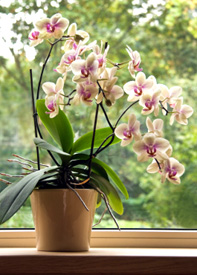
For orchid lighting, Phalaenopsis orchids do best in indirect sunlight, as opposed to full direct sunlight exposure. You may never have thought about where the sun is coming in your windows or garden, but when you have plants, it gives you extra incentive to pay attention to the wonders of nature!
Since the sun rises in the East and sets in the West, windows facing those directions without anything to offer shade will get direct sunlight for at least a few hours of the day—the beginning or the end. Without curtains or something to diffuse the light, this may be too much for your orchid. The best choice is probably a North-facing window or an East-facing one. For rooms with windows on the South or West, you can place your orchid plant further into them room away from any direct sunlight coming in the windows. Watch for orchid sunburned leaves or dropping blooms, which are your indications that your plant is getting too much light.
If you’re keeping your orchid outside for certain portions of the day or during warm weather, you’ll need to take note of the shape of your garden, and the general surroundings. Are there tall trees or buildings that block out the sun? Do you have umbrellas or other décor that offers shade? Go out at different times of the day and see which areas are getting the most sun, and which don’t get any.
Remember that Phalaenopsis orchids grow on the trunks of trees in nature, getting shade from the canopy above. The closer you can get to re-creating their natural habitat, the happier they’ll be!
For more help with finding the right place for your orchid, read this article from the American Orchid Society: Orchid Culture - Growing Outdoors and in Windows.

Copyright Just Add Ice® Orchids 2023